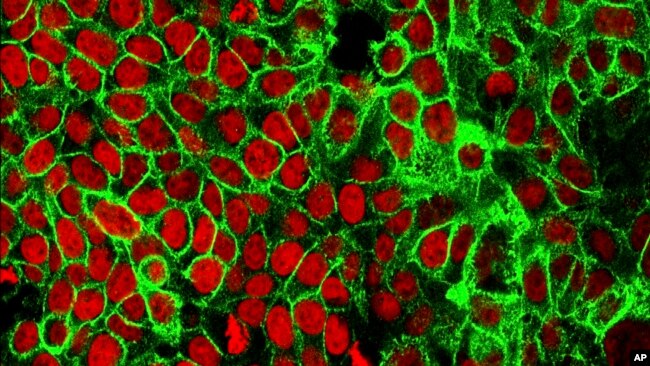ゲノム研究が導く、癌細胞への標的治療
素晴らしい!!!
変異パターンによる個別化医療による早期治療!!
今日もVOAで楽しく英語を学びましょう!!
がん遺伝子の研究により、標的治療への貢献が期待できる(和訳)
Study of Cancer Genetics to Help with Targeted Treatment
May 04,2022
科学者たちは、18,000以上の癌サンプルの全遺伝情報を調査しました。彼らは、医師がより良い治療を提供するのに役立つ変異、または変更のパターンに関する新しい情報を発見しました。
彼らの研究は、最近出版されたサイエンスに掲載されたもので、癌サンプルのこれほど完全な遺伝子研究を行ったのは初めてではありませんが、これほど大規模なサンプルサイズを使用した例はありません。
ケンブリッジ大学のセリーナ・ニク・ザイナル氏は、この研究を行ったチームの一員でです。彼女は、これが”世界最大の共通項(共通した因子を持ち、観察対象となる集団)で驚異的だ。"と述べました。
この研究の12,000以上のサンプルは、英国の国民健康保険サービスによって募集された患者から得られたものです。彼らは、一般的な癌や稀な病気の人々の全ゲノムを研究するプロジェクトの一部でした。残りのデータは、既存の癌データセットから得られたものです。
研究者たちは、最近、科学者たちがヒトゲノム全体の地図を完成させたのと同じ技術の向上により、このような数の研究を行うことができたのです。
ヒューストンのMDアンダーソン癌センターのゲノム専門家であるアンドリュー・フュートリアル氏は、この研究には関与していません。彼は、この研究は科学者に癌の原因となる破壊的な力についてある程度の知識を与えるものであると語っています。
癌はゲノム、あるいは細胞を動かすための命令書のフルセットの病気です。人のDNAに変化が生じ、細胞が制御不能に増殖、分裂することによって起こります。DNAとは、人間のような生き物の細胞内にある遺伝情報を担う物質です。2020年、世界では新たに約1900万人のがん患者が発生しました。
今回の研究では、研究者は人体に存在する19種類の癌を調べました。その結果、58の新しい”変異サイン”、つまりがんの原因につながる証拠の断片が確認されました。また、これまでに報告された70以上の変異パターンのうち、51パターンが確認されたとニク・ザイナル氏は述べています。あるものは人の細胞内の問題から生じ、またあるものは紫外線、タバコの煙、化学物質によって引き起こされます。
これらの変異をより多く知ることは、”一人ひとりの癌をより正確に理解することにつながり、治療の指針になる”とニク・ザイナル氏は述べています。
細胞の構造を調べるために使用される遺伝子配列決定は、すでに癌治療に取り入れられています。これは、患者の遺伝子と特定の病気に基づいた治療、つまり個別化医療を目指す動きが活発化していることの一部です。現在、医師は個々のがんを観察する際に、より多くの情報を得ることができます。
この情報を医師が活用できるように、研究者らは、一般的な変異パターンを見つけ、稀な変異を探し出すことができるコンピュータープログラムを開発しました。ニク・ザイナル氏によれば、医師は特殊なパターンに基づいて治療法を提案することができると言います。
フュートリアル氏は、このデータは、患者がある突然変異パターンを持つ癌を発症した場合、時間の経過とともにどのような傾向があるかを医師に示すこともできると言います。これによって、医師はより早い段階で治療を行うことができ、うまくいけば病気の発生を食い止めることができます。
Study of Cancer Genetics to Help with Targeted Treatment
Scientists have studied the full genetic information of more than 18,000 cancer samples. They found new information about the patterns of mutations, or changes, that could help doctors provide better treatment.
Their study, which appeared recently in the publication Science, is not the first to do such a complete genetic study of cancer samples. But no one has ever used such a large sample size.
Serena Nik-Zainal of the University of Cambridge was part of the team that did the research. She said this was “the largest cohort in the world. It is extraordinary."
Over 12,000 samples in the study came from patients recruited by Britain’s National Health Service. They were part of a project to study whole genomes from people with common cancers and rare diseases. The rest of the data came from existing cancer data sets.
Researchers were able to study such a large number because of the same improvements in technology that recently permitted scientists to complete the map of the entire human genome.
Andrew Futreal, a genomic expert at MD Anderson Cancer Center in Houston, was not involved in the study. He said the study gives scientists some knowledge of the destructive forces that cause cancer.
Cancer is a disease of the genome or full set of instructions for running cells. It happens when changes in a person’s DNA cause cells to grow and divide uncontrollably. DNA is a substance that carries the genetic information in the cells of living things, like a human. In 2020, there were about 19 million new cancer cases worldwide.
For the study, researchers looked at 19 different kinds of cancer in the human body. It identified 58 new “mutational signatures,” or pieces of evidence leading to the causes of cancer. Nik-Zainal said researchers also confirmed 51 of more than 70 previously reported mutation patterns. Some arise because of problems within a person’s cells; others are caused by ultraviolet radiation, tobacco smoke, or chemicals.
Knowing more of them “helps us to understand each person’s cancer more precisely,” which can help guide treatment, Nik-Zainal said.
Genetic sequencing, the process used to study the makeup of a cell, is already being included in cancer care. It is part of the growing move toward personalized medicine, or care based on a patient’s genes and specific disease. Now doctors will have much more information to draw from when they look at individual cancers.
To help doctors use this information, researchers developed a computer program that will let them find common mutation patterns and seek out rare ones. Nik-Zainal said doctors could suggest a treatment based on a special pattern.
Futreal said the data can also show doctors what tends to happen over time when a patient develops a cancer with a certain mutation pattern. This will help doctors give earlier treatment and hopefully stop the developing disease.
Words in This Story
sample – n. a group of people or things that are taken from a larger group and studied, tested, or questioned to get information
pattern – n. the regular and repeated way in which something happens
mutation – n. a change in hereditary material
cohort – n. a group of individuals having something (usually a statistical factor) in common in a study
genome – n. the complete set of genes in a cell or organism
DNA – n. a substance that carries genetic information in the cells of plants and animals
